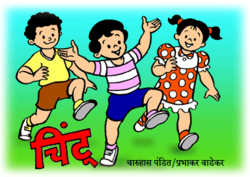(Last month, Tap ‘n Tap, a Boston based startup that has a development center in Pune, and which aims to “bring multiple iPad competitors to the market”, announced that it has raised $2.25 million in Series A funding led by New Atlantic Ventures. PuneTech interviewed Nitin Sonawane, co-founder of Tap ‘n Tap, and an ex-Pune-Nashik-ite, who is currently visiting Pune.
For more background on Tap ‘n Tap, see this MIT Tech Review article and this this detailed profile from MassHighTech.com
Disclaimer: Navin is a consultant for Tap ‘n Tap, and hence the PuneTech blog never covered Tap ‘n Tap, in keeping with PuneTech’s editorial policy. However, a Series A funding round is a rare and significant enough occurrence, that we felt justified in post.)
Nitin, congratulations on getting funded. Can you give us an overview of what Tap ‘n Tap does?

Tap ‘n Tap is a software and user experience design company. We are building a complete OS for Web connected Tablet devices. Tap ‘n Tap was founded almost two years ago, long before Tablet’s were cool. We envisioned a category of handheld touchscreen devices to conveniently enjoy best of the web at home.
Today people connect to the internet primarily through PCs and smartphones. PCs, while powerful, are not always-on and nearby where people spend time at home. Smartphones, while great on the go, have small displays that limit website viewing. Tablets fill in this gap in our enjoyment of the web at home.
Tablets can be permanently kept in high-traffic areas of the home on the wall or tabletop, and will be always-on while docked. The devices can also be removed from their dock and used in handheld mode at the kitchen table, on the sofa, in your bed, or anywhere in the home.
We believe these devices will become part of the daily life of a family and shared by everyone.
So your product is actually a handheld device targeting family audience for home use. Are you a hardware or a software company, or both?

Good question. We are actually a software and user experience design company. On a Tablet device a great user experience is critical. Now while the UI is what the user sees, behind it needs to be extremely well engineered software.
So Software and User Experience is our core competence. We are partnering with multiple hardware manufacturers, including OEMs, to bring our software solution on their devices.
I believe you’ve been working on this for a while now – before Apple announced the iPad. How does Apple’s entry into this market, and and apparent success of the iPad affect it?
We see the iPad as a very positive development for us. Apple has now established that there is a market for Tablets, and lots of other large players want to follow. We believe we are in a unique position to help them get to the market fast with a high quality product that will be needed to be able to compete effectively.
Apple is a large company which would have put in tons of resources to come up with its offering. How does a small company like yours match up to it?
Our software stack is based on the Android framework. So we are leveraging the work that Google and other open source developers have done for Smartphones. This allows our team to focus on what we really want to focus on – which is to build a really compelling and “wow!” Tablets . While we focus on the core of the Tablet product, Android also allows us to bring great third party applications written for Android smartphones to the Tablet world
If that is the case, what is the barrier to entry for any small company to come up with a similar offering?
History has repeatedly proved that building a really compelling and “wow!” product is very difficult. It cannot be done by just throwing a bunch of developers at it. What is needed is an intersection of top quality design and some really challenging technical problem solving to implement that design. Designing a great user experience requires some very smart usability people, and is something that developers, or “average” “ui designers” cannot really do; and implementing it to perfection requires very talented engineers, and is something that average engineers fail at. What happens when the design calls for capabilities that don’t really exist in the underlying software platform? What happens if a particular feature runs a little too slowly on the given hardware? An average-to-good developer will tweak the design to fit within the limitations of the software/hardware, and in the process killing the user experience without even realizing it. A great engineer will go to great lengths to make it happen without compromising the integrity of the design.
And you think that kind of talent is available in Pune?
Absolutely! Pune definitely has both, the design talent pool and the developer talent pool that can build a product on par with the best in the world. We have already formed the seeding team of both types of people and are actively looking at adding to it.
The process of setting up such a team has been both challenging and fulfilling. Our selection criteria went beyond the traditional ones of experience and software skills. We hired people with the ability to simplify complexity, very good problem solving skills and the ability to come up with multiple solutions to difficult problems and select the one that will appeal to users. Needless to say, they also looked for the ability to work under pressure that start-ups demand. We continue to look for the right talent to add to this strong team.
Why did you pick Pune? How did you go about it?
Pune has long been a high-tech center with a lot of world class colleges in the vicinity. There is high quality talent available and I happen to know this first hand :-).
We decided that for ramping up quickly, instead of starting from scratch, we would be better off partnering with some startup in Pune who could help us build our team. We picked Clarice Technologies because it had a very strong background in both core software technology, as well as usability and user interaction design – a combination that is not only difficult to find, but also absolutely essential to the success of Tap ‘n Tap.
The team in Pune is integrated with the team in Boston, we’re involved in all the hiring decisions, and as far as we are concerned, every member of the team is a Tap ‘n Tap employee.
Also, we are not viewing the India team as a source of cheap labour for low-end work. We want to tap the Pune talent pool and are willing to pay for it. The team here has the entire responsibility for a bunch of modules of the software stack. This includes everything, right from conceptualization of that the requirements for the module would be, to architecture, design and implementation. If you take a look at some of the things our team here has done, you’d think it came from Google or Apple. Their work so far is really world class and we expect that to continue and grow.





![Reblog this post [with Zemanta]](http://img.zemanta.com/reblog_b.png?x-id=bbdc62dc-5b19-43b6-8a07-5746a2cfb23e)


![Reblog this post [with Zemanta]](http://img.zemanta.com/reblog_b.png?x-id=97e7e7fc-34b4-4c85-b8f9-fa1af3e5b201)



![Reblog this post [with Zemanta]](http://img.zemanta.com/reblog_b.png?x-id=d1ca606d-fe9c-40fc-8e96-f96069defbaa)